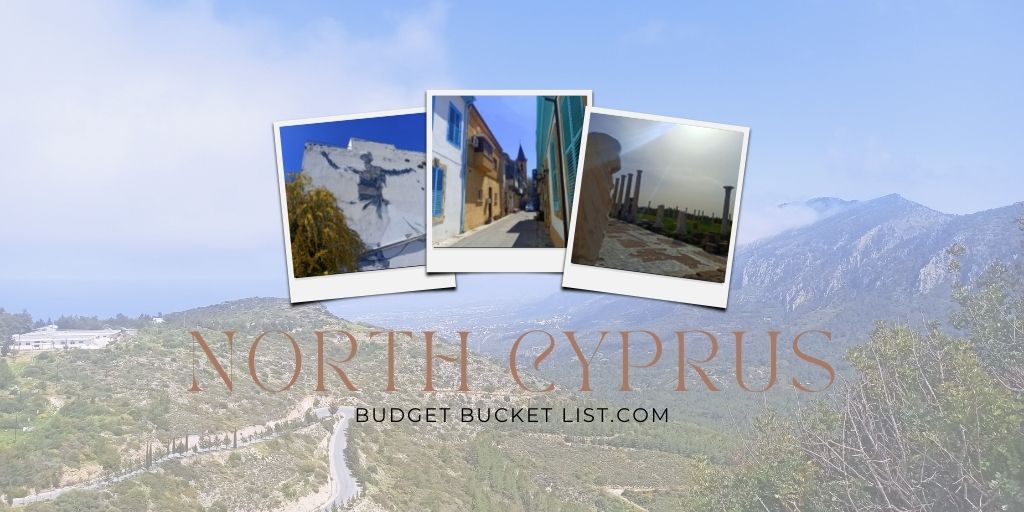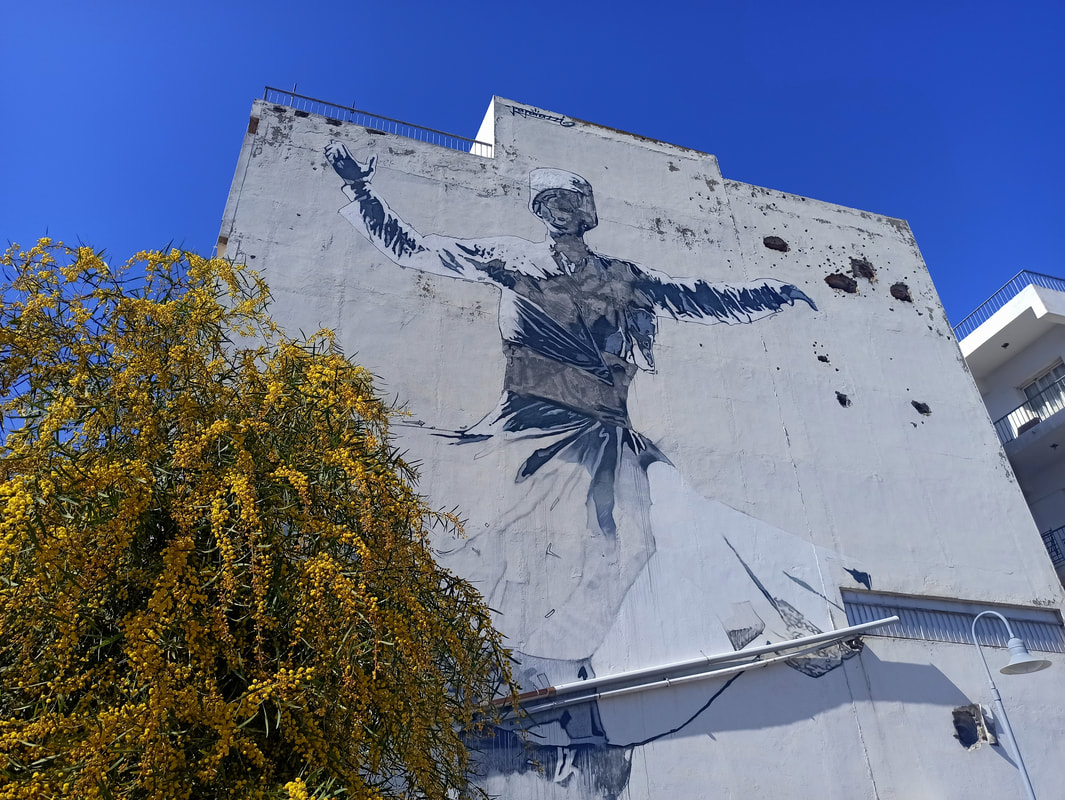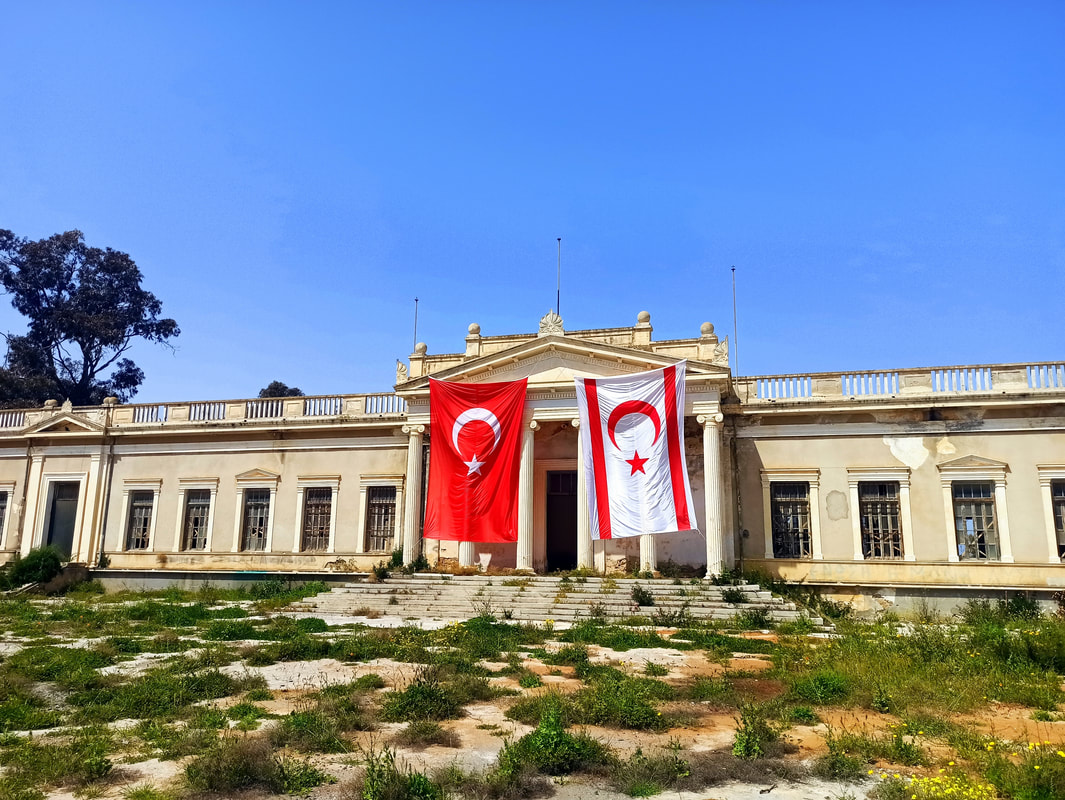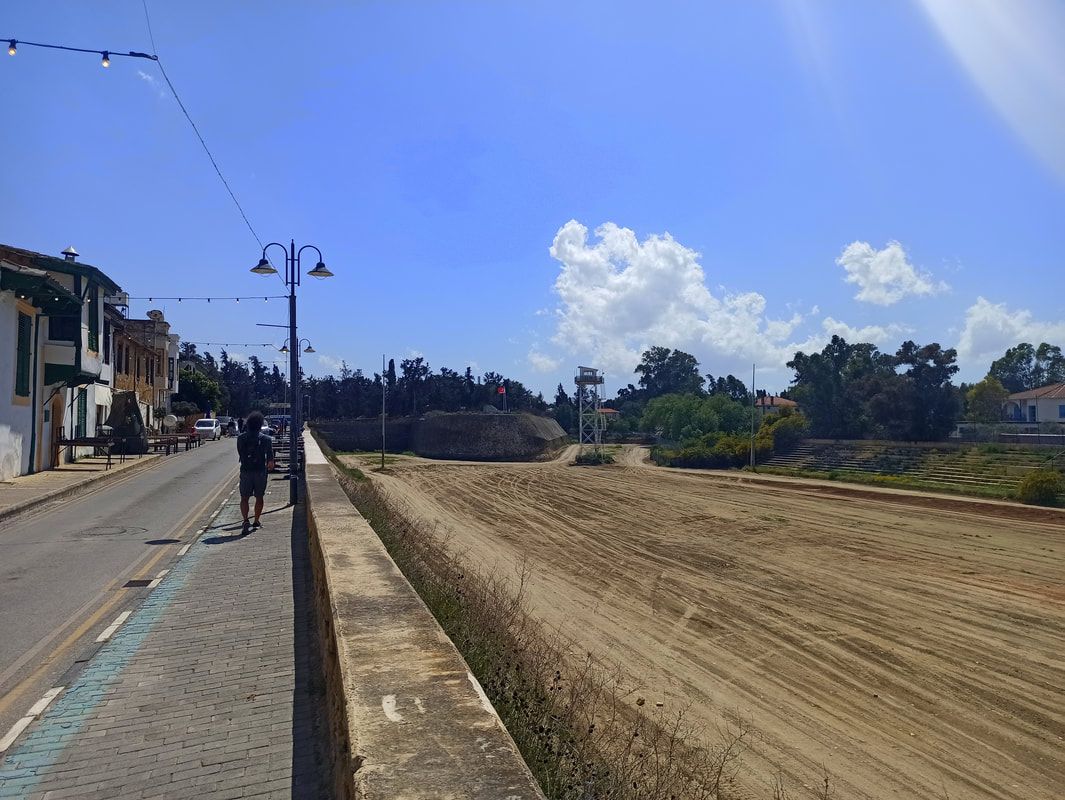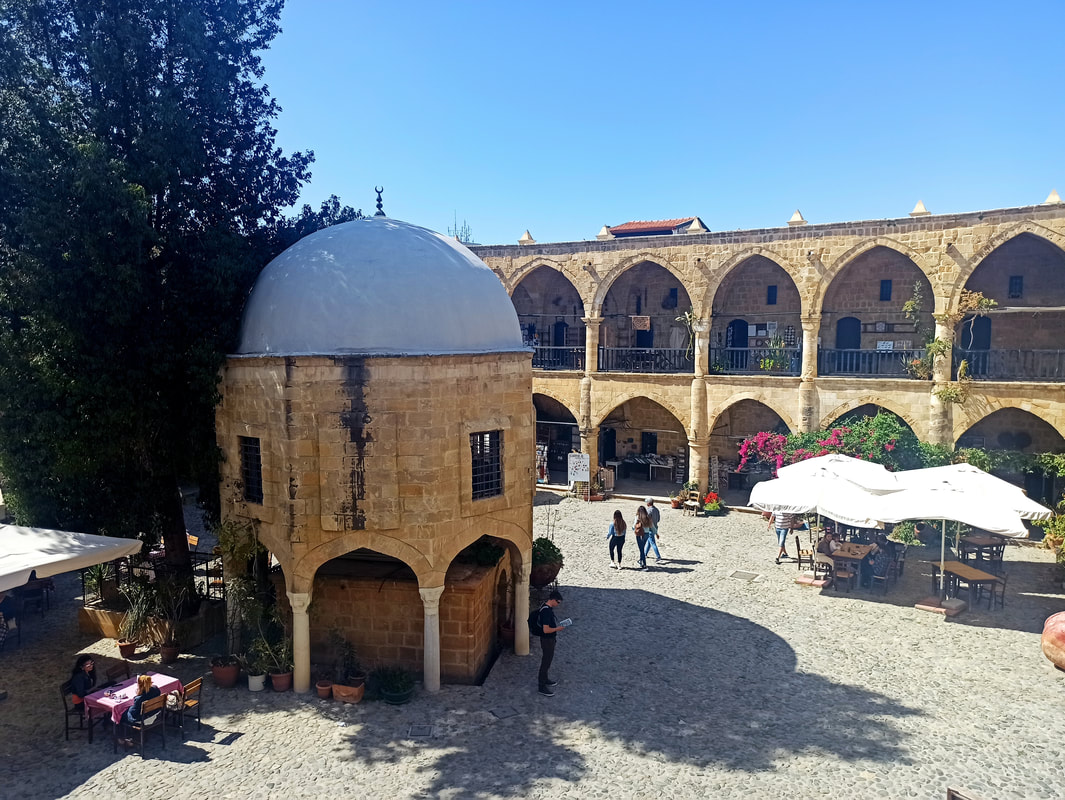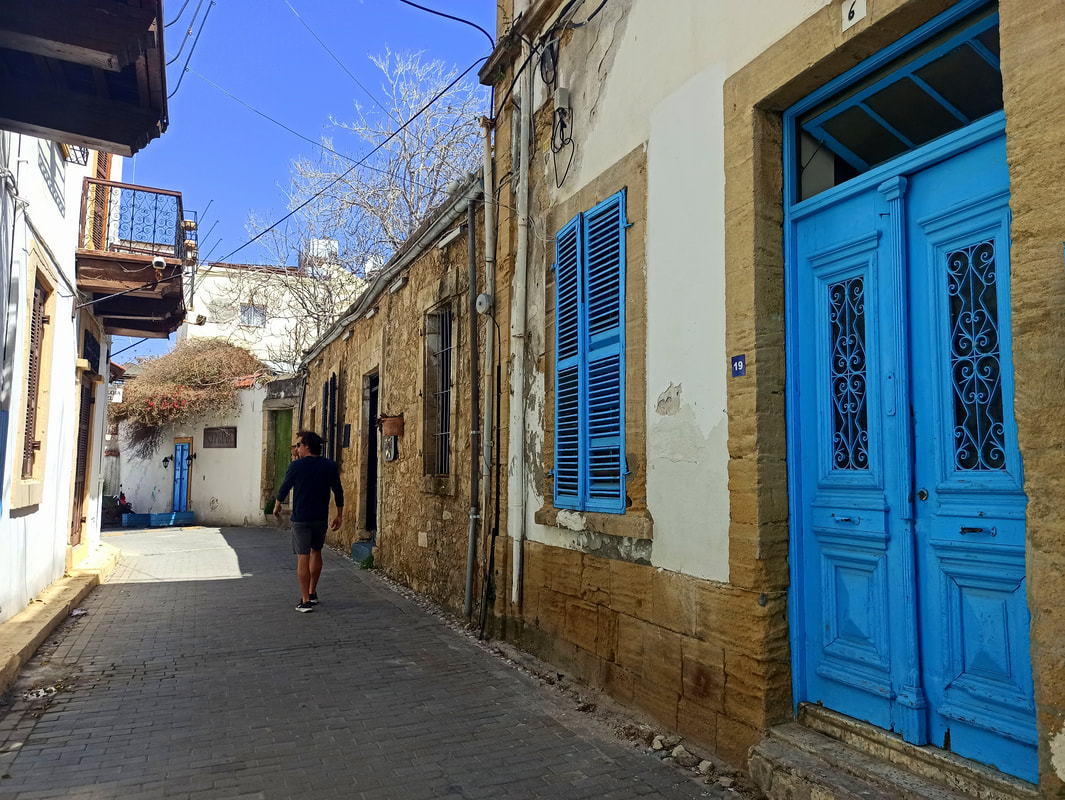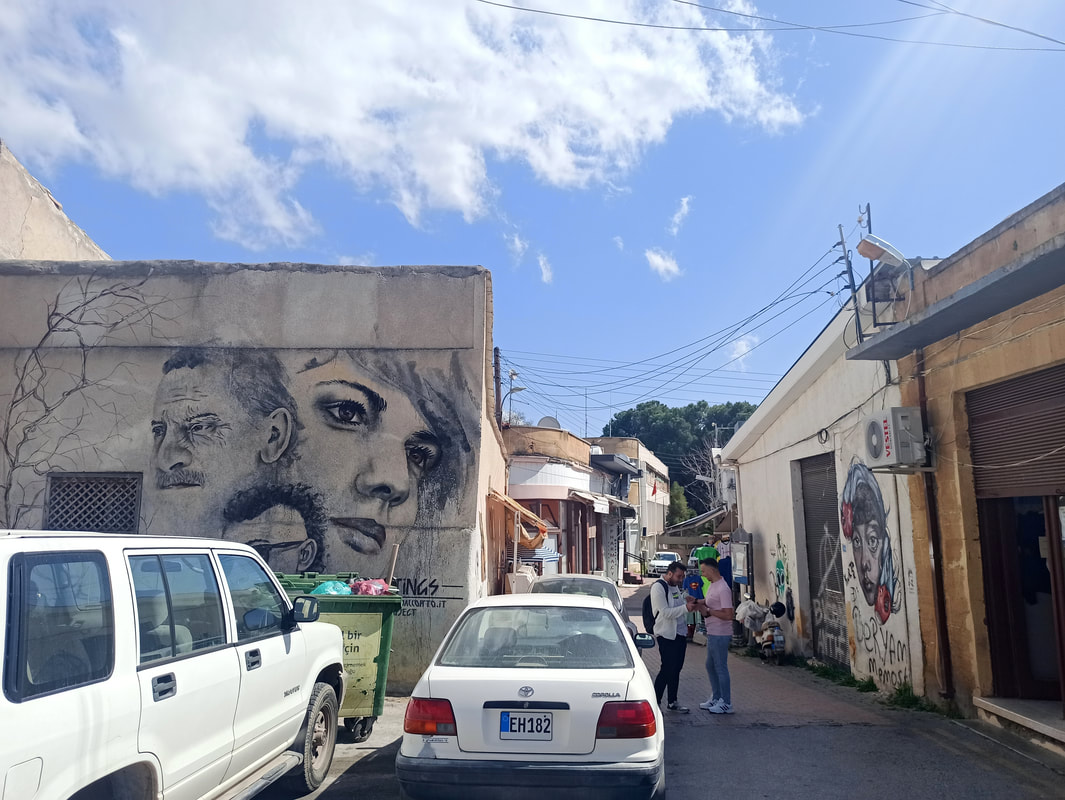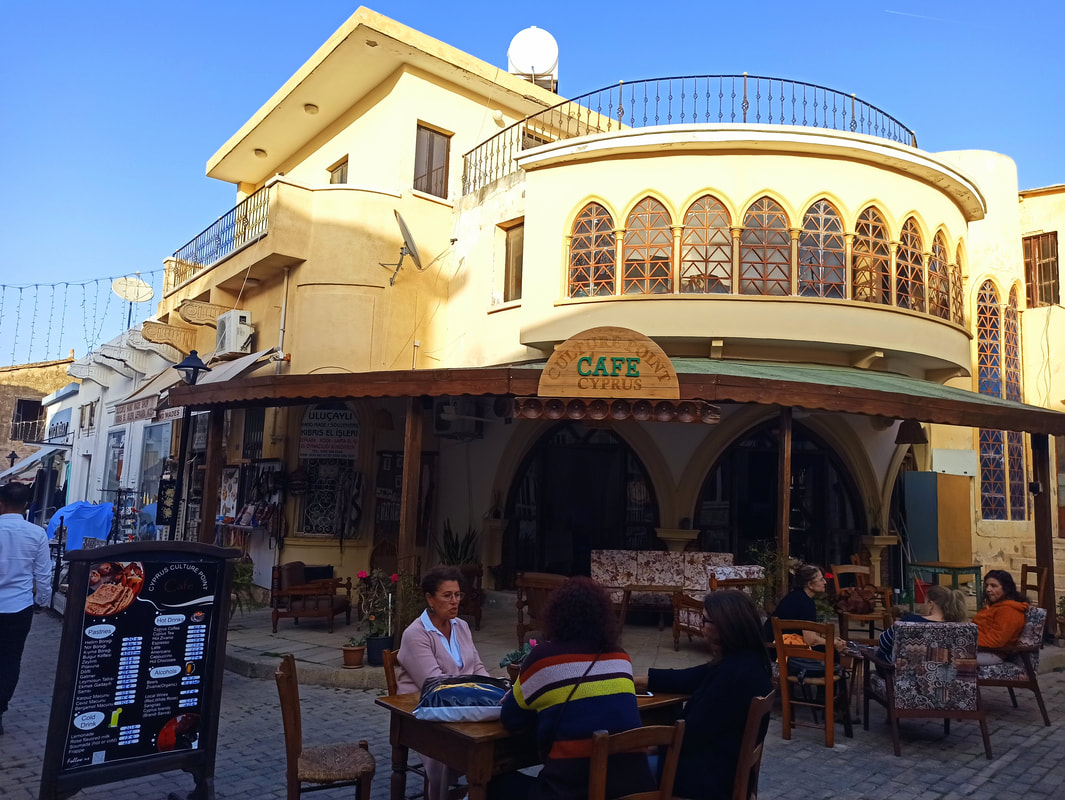North Cyprus
Not in the story-mood? Scroll down for the Quick Budget Fact Overview: an itemized information summary of Cyprus! ↓
Cyprus is a country with two faces. Quite literally, as the island has been divided into two separate parts with a radical border cutting straight through the middle. On one side of that division you will find the southern “Republic of Cyprus” under Greek influence, on the other side sits the de-facto state called the “Turkish Republic of Northern Cyprus”.
Wow, what happened?
The answer to that question depends on who you ask, the Greek or the Turkish Cypriots... As quoted from an article published on the website of Turkey’s Ministry of Foreign Affairs: “The Island of Cyprus […] has been a land of many conquests due to its proximity to the Middle Eastern countries and its strategic location at the cross-road of East and West. Cyprus has seen a succession of rulers, namely Assyrians, Egyptians, Persians, Romans, Arabs, Crusaders and Turks, who ruled the island as part of the Ottoman Empire from 1571 until 1878.” Whereas the Turks claim that Cyprus has never been a Greek island, the island did experience two waves of Greek (Mycenaean) settlements as early as the Bronze Age and was subjected to some hardcore Hellenization after the conquest by Alexander the Great in 333BC. On top of that, Cyprus occupies a major role in Greek mythology, being considered the birthplace of both Aphrodite and Adonis. However, as a result of the long period of Ottoman rule, the two main population groups in recent times were made up by the Orthodox Christian Greek Cypriots (majority), as well as the Muslim Turkish Cypriots (minority). Even though these ethnicities have lived side by side on the island for centuries, inter-marriages and business partnerships were rather uncommon.
Wow, what happened?
The answer to that question depends on who you ask, the Greek or the Turkish Cypriots... As quoted from an article published on the website of Turkey’s Ministry of Foreign Affairs: “The Island of Cyprus […] has been a land of many conquests due to its proximity to the Middle Eastern countries and its strategic location at the cross-road of East and West. Cyprus has seen a succession of rulers, namely Assyrians, Egyptians, Persians, Romans, Arabs, Crusaders and Turks, who ruled the island as part of the Ottoman Empire from 1571 until 1878.” Whereas the Turks claim that Cyprus has never been a Greek island, the island did experience two waves of Greek (Mycenaean) settlements as early as the Bronze Age and was subjected to some hardcore Hellenization after the conquest by Alexander the Great in 333BC. On top of that, Cyprus occupies a major role in Greek mythology, being considered the birthplace of both Aphrodite and Adonis. However, as a result of the long period of Ottoman rule, the two main population groups in recent times were made up by the Orthodox Christian Greek Cypriots (majority), as well as the Muslim Turkish Cypriots (minority). Even though these ethnicities have lived side by side on the island for centuries, inter-marriages and business partnerships were rather uncommon.
When the Ottoman Empire dissolved, the island came under British control, much to the dissatisfaction of the Greek Cypriots who desired a union with Greece: the so-called “Enosis.” Needless to say, the Turkish Cypriots opposed these ambitions and the sought-after Hellenization, which clashed with their culture and religion. It didn’t help that the 1955 unification campaign was led by Archbishop Makarios, who didn’t shy away from violence to anyone opposing his ideas (including Greek officials). In 1960, Cyprus managed to become independent from Britain, introducing a bi-communal partnership republic between the two ethnicities. Equal rights and a weighted power-sharing ratio were key points of this new constitution. That said, even though Makarios was previously sent into exile, he returned and was appointed the first president of Cyprus… never having changed his Enosis-centred ideas. As such, a “partnership” was far from the reality, which was marked with violence between the Turkish and Greek communities. Dissatisfaction in Greece with Makarios’ governing triggered a Greek junta-backed coup in 1974, allegedly aiming to unite Cyprus with Greece. This was immediately followed up with a Turkish military invasion, leading to the division of the island into two separate entities: 1/3 the Turkish Cypriot North, 2/3 the Greek Cypriot South, forcing each population group into “their own area”.
The Divided Island
Even though the occupation was never internationally recognized and the conflict continued, the Turkish Cypriot state declared its independence in 1983 under the name of “Turkish Republic of Northern Cyprus”… which is recognized only in Turkey. In their turn, Turkey refused to acknowledge the existence of the Republic of Cyprus and its administration over the North. Where the Turkish Cypriots feared the Hellenization of Cyprus, the Greek Cypriots now express a similar fear: “Turkey has implemented a systematic policy of settlement of the occupied part of Cyprus since 1974 with the mass transfer of more than 160,000 Turks from Turkey in order to change the demographic profile and alter the population balance on the island. […] This policy, together with driving the Greek-Cypriot inhabitants out of the region, the destruction of the cultural heritage, and the illegal change of geographical place names in the occupied part of Cyprus, aims at the elimination of every single, centuries-old Greek and Christian element, and eventually the ‘Turkification’ of the region.” [Quotation of Cyprus’ Ministry of Foreign Affairs website]. That said, recent developments have caused the border to reopen, making traffic between the two entities possible.
However, Cyprus remains divided until today.
Even though the occupation was never internationally recognized and the conflict continued, the Turkish Cypriot state declared its independence in 1983 under the name of “Turkish Republic of Northern Cyprus”… which is recognized only in Turkey. In their turn, Turkey refused to acknowledge the existence of the Republic of Cyprus and its administration over the North. Where the Turkish Cypriots feared the Hellenization of Cyprus, the Greek Cypriots now express a similar fear: “Turkey has implemented a systematic policy of settlement of the occupied part of Cyprus since 1974 with the mass transfer of more than 160,000 Turks from Turkey in order to change the demographic profile and alter the population balance on the island. […] This policy, together with driving the Greek-Cypriot inhabitants out of the region, the destruction of the cultural heritage, and the illegal change of geographical place names in the occupied part of Cyprus, aims at the elimination of every single, centuries-old Greek and Christian element, and eventually the ‘Turkification’ of the region.” [Quotation of Cyprus’ Ministry of Foreign Affairs website]. That said, recent developments have caused the border to reopen, making traffic between the two entities possible.
However, Cyprus remains divided until today.
Visiting North Cyprus
Traffic between the two entities of Cyprus is very straightforward. You can simply walk or drive from one side to the other. Expect a situation similar to any land border you have crossed: You’ll be required to show your passport when leaving one side, and you’ll have to show it again when entering the other. The most popular border is the Ledra Street Crossing, located right within the Old Town of the capital Nicosia / Lefkoşa. On the Southern side there are several buses leading to alternative border crossings aimed for vehicle traffic (for example the one close to Ayia Napa), but on the Northern side public transport options are limited or entirely absent at these crossing points… so your own vehicle or comfortability with hitchhiking is necessary when selecting these checkpoints (luckily, autostop is much easier in the North than in the South).
Traffic between the two entities of Cyprus is very straightforward. You can simply walk or drive from one side to the other. Expect a situation similar to any land border you have crossed: You’ll be required to show your passport when leaving one side, and you’ll have to show it again when entering the other. The most popular border is the Ledra Street Crossing, located right within the Old Town of the capital Nicosia / Lefkoşa. On the Southern side there are several buses leading to alternative border crossings aimed for vehicle traffic (for example the one close to Ayia Napa), but on the Northern side public transport options are limited or entirely absent at these crossing points… so your own vehicle or comfortability with hitchhiking is necessary when selecting these checkpoints (luckily, autostop is much easier in the North than in the South).
Be aware: South Cyprus considers anyone who has entered / exited via the North (Ercan airport or the northern harbours) to have entered / exited the country illegally. You can traverse between the two sides without any issues, but you could potentially run into trouble when entering on one side and exiting on the other, as these separate entities don’t recognize each other. Keep also in mind that the South is part of the EU (but NOT of Schengen – as per 2022), and the North isn’t.
Recommended Destinations in North Cyprus
Gazimağusa (Famagusta)
One of the most beautiful features characterizing my time in Northern Cyprus is the multiculturality of the current population. Perfectly in line with Cyprus’ history, you’ll find big expat populations of Greeks and Brits in the South, while in the North I had the pleasure to be hosted by Turkish, Egyptian and Syrian hosts. When we arrived in Gazimaguša (my first stop in the North), the Ramadan had just started and the Syrian ensemble of three cousins welcoming us with open arms made sure we wouldn’t miss out on the first celebratory “iftar” (post-sunset meal). Wait, is this still the same country? Yes, quite delightfully so!
The history of Gazimaguša can be traced back to approximately 285-247BC, when it was founded by the Egyptian King Ptolomeus* after the back-then-capital Salamis was severely damaged by earthquakes and an alternative base was desired. As in the centuries to follow Salamis became the target of Arab raids, a gradual evacuation of the total population towards Gazimaguša took place, allowing the city to develop from a fisherman village into a significant port town. Nowadays, the archaeological site housing the remains of Salamis** can still be visited, and I warm-heartedly recommend this daytrip to anyone who has the slightest affinity with ancient history. Side-note: If you, like me, caress faint memories of history classes covering the Greek-Persian “Battle of Salamis” (or simply enjoyed the movie “300”), don’t be mistaken… this is a different Salamis! There was a naval Battle of Salamis in Cyprus: in 306BC between Ptolemy I of Egypt and Antigonus I Monophthalmos’ son Demetrius (who sailed out of Athens)… but that’s not the same one as the earlier Battle of Salamis from 480BC between the Greek city-states and the Persian Empire under King Xerxes, which was fought out close to Athens.
* Back then, the city was named Arsinoe, after Ptolemy’s sister.
** Free entrances to the site can be found all around, as the gate has many openings… so I guess paying is optional.
When you’re already in Salamis, you can make the effort to visit the St. Barnabas Monastery and Icon Museum, which is in relatively close proximity. St. Barnabas, who is buried here, is worshiped as one of Christianity's most important saints and the founder of the Christian Church in Cyprus.
Recommended Destinations in North Cyprus
Gazimağusa (Famagusta)
One of the most beautiful features characterizing my time in Northern Cyprus is the multiculturality of the current population. Perfectly in line with Cyprus’ history, you’ll find big expat populations of Greeks and Brits in the South, while in the North I had the pleasure to be hosted by Turkish, Egyptian and Syrian hosts. When we arrived in Gazimaguša (my first stop in the North), the Ramadan had just started and the Syrian ensemble of three cousins welcoming us with open arms made sure we wouldn’t miss out on the first celebratory “iftar” (post-sunset meal). Wait, is this still the same country? Yes, quite delightfully so!
The history of Gazimaguša can be traced back to approximately 285-247BC, when it was founded by the Egyptian King Ptolomeus* after the back-then-capital Salamis was severely damaged by earthquakes and an alternative base was desired. As in the centuries to follow Salamis became the target of Arab raids, a gradual evacuation of the total population towards Gazimaguša took place, allowing the city to develop from a fisherman village into a significant port town. Nowadays, the archaeological site housing the remains of Salamis** can still be visited, and I warm-heartedly recommend this daytrip to anyone who has the slightest affinity with ancient history. Side-note: If you, like me, caress faint memories of history classes covering the Greek-Persian “Battle of Salamis” (or simply enjoyed the movie “300”), don’t be mistaken… this is a different Salamis! There was a naval Battle of Salamis in Cyprus: in 306BC between Ptolemy I of Egypt and Antigonus I Monophthalmos’ son Demetrius (who sailed out of Athens)… but that’s not the same one as the earlier Battle of Salamis from 480BC between the Greek city-states and the Persian Empire under King Xerxes, which was fought out close to Athens.
* Back then, the city was named Arsinoe, after Ptolemy’s sister.
** Free entrances to the site can be found all around, as the gate has many openings… so I guess paying is optional.
When you’re already in Salamis, you can make the effort to visit the St. Barnabas Monastery and Icon Museum, which is in relatively close proximity. St. Barnabas, who is buried here, is worshiped as one of Christianity's most important saints and the founder of the Christian Church in Cyprus.
Another significant event in Gazimaguša’s history is marked by the Lusignan rule (French) from 1192 on, followed up by the conquest of Genoa in 1372 and by Venice in 1489 (Italian). Many structures in the charming old centre remind us about these times, including the old city walls, the ruins of the Church of St. Francis of Assisi and the Twin Churches of the Templars and Hospitallers of the order of St. John (protecting Christian pilgrims on their way to the Holy Land). The Venetian Governor’s Palace was built on the ruins of a Lusignan one, containing Roman columns salvaged from the ancient site of Salamis. The so-called “Othello Castle” was nicknamed this way during the later British occupation, due to Shakespeare’s play referring to “a port in Cyprus”. It is suggested that Othello, who kills his wife Desdemona, may be based upon the Governor of Cyprus between 1505 and 1508: Lieutenant Cristoforo Moro. The current Lala Mustafa Pasha Mosque is originally the Lusignan St. Nicholas Cathedral, with simply a minaret added to this entirely gothic-style building.
Cyprus fell to the Ottomans in 1571… and the north once again in 1974 in the ongoing unresolved conflict. An interesting “dark tourism” location connecting to the Cyprus dispute, is a visit to the abandoned Ghost Town of Varosha. The southern quarter of this former tourist hotspot has been occupied by the Turkish Cypriot military from 1974 on and is strictly inaccessible… but since recent years more and more parts have been opened to the public, eager to explore* this overgrown and decayed time capsule of forlorn times. An unusual activity during your laidback island getaway?
* Whatever you do: don’t rent a bicycle, even if it’s the hottest day of summer! We couldn’t properly sit down for days to follow after being subjected to the tortures of those human-hating bicycle seats.
Cyprus fell to the Ottomans in 1571… and the north once again in 1974 in the ongoing unresolved conflict. An interesting “dark tourism” location connecting to the Cyprus dispute, is a visit to the abandoned Ghost Town of Varosha. The southern quarter of this former tourist hotspot has been occupied by the Turkish Cypriot military from 1974 on and is strictly inaccessible… but since recent years more and more parts have been opened to the public, eager to explore* this overgrown and decayed time capsule of forlorn times. An unusual activity during your laidback island getaway?
* Whatever you do: don’t rent a bicycle, even if it’s the hottest day of summer! We couldn’t properly sit down for days to follow after being subjected to the tortures of those human-hating bicycle seats.
FREE Recommended Sights / Activities
PAID Recommended Sights / Activities
Evening Entertainment
[Scroll down for further items of the Budget Fact Overview: Cyprus Facts; Short History Recap; Budget Bites; Sleep Cheap; Mama Said; Transport; Where To Next.]
- Sights: Old Town; Church of St. Francis of Assisi; Twin Churches; Venetian Governor’s Palace; Othello Castle; Archeaological Site of Salamis (when entering through the secret free entrances); Varosha Ghost Town; Lala Mustafa Pasha Mosque (St. Nicholas Cathedral) & more mosques.
- Hikes / Nature: Glapsides Beach; Silver Beach.
PAID Recommended Sights / Activities
- Sights: St. Barnabas Monastery and Icon Museum.
Evening Entertainment
- Nightlife Areas: Old Town.
[Scroll down for further items of the Budget Fact Overview: Cyprus Facts; Short History Recap; Budget Bites; Sleep Cheap; Mama Said; Transport; Where To Next.]
Lefkoşa (Nicosia)
This is very likely the first destination in Northern Cyprus you will enter, after crossing the pedestrian Ledra Street Checkpoint. I’m aware that many locals prefer the coastal towns over their biggest city, but I just couldn’t get enough of the charm and pleasant chaos of Cyprus’ bustling capital. The mere fact that it’s the last divided capital in the world, brutally split in two with a border scarring the very heart of its alluring Old Town, endlessly fascinates me. As mentioned, you need your passport to hop from one side to the other, and a proper culture shock is included in the experience. On the south-side you find yourself strolling through modern, perfectly aligned streets… even the historical colorful sandstone housing and monuments immaculately groomed for the eye of the public, without losing the connection with is Greek Cypriot cultural essence. The second you reach the other side of the frontier, your eye is instantly met with the delightful commotion of knock-off brands street merchants, the traditional pranking icecream-vendors and shop windows gloriously displaying sweet dripping baklava. Two different worlds cropped within those ancient city walls!
This is very likely the first destination in Northern Cyprus you will enter, after crossing the pedestrian Ledra Street Checkpoint. I’m aware that many locals prefer the coastal towns over their biggest city, but I just couldn’t get enough of the charm and pleasant chaos of Cyprus’ bustling capital. The mere fact that it’s the last divided capital in the world, brutally split in two with a border scarring the very heart of its alluring Old Town, endlessly fascinates me. As mentioned, you need your passport to hop from one side to the other, and a proper culture shock is included in the experience. On the south-side you find yourself strolling through modern, perfectly aligned streets… even the historical colorful sandstone housing and monuments immaculately groomed for the eye of the public, without losing the connection with is Greek Cypriot cultural essence. The second you reach the other side of the frontier, your eye is instantly met with the delightful commotion of knock-off brands street merchants, the traditional pranking icecream-vendors and shop windows gloriously displaying sweet dripping baklava. Two different worlds cropped within those ancient city walls!
Personally, I had the great pleasure to be hosted in the northern part by one of the kindest and generous humans I met in the past few years. The Turkish Mutlu personified the hospitality his homeland holds a reputation for, while sharing his appreciation for his new homebase Cyprus and the culinary traditions of the island. I learned that a “mezze” isn’t just an insane amount of mouth-watering food to be consumed over the course of a couple of hours… it also represents a keystone of local culture and the social fibre. The mezze is served in both the Greek and Turkish areas of Cyprus, but prices are much lower on the northern side. Actually, everything is cheaper on the Turkish side, which makes this part of Lefkoşa your best bet for shopping as well as partying. When here, also make sure to check out the Büyük Han, the traditional Ottoman “inn” constructed in 1572 to cater to the swarming crowds of international traders and vendors hawking their wares on the island. I found however the Greek side much more organized when it comes to their offer in museums, of which there are enough to fill an entire weekend with. I visited the Municipal Gallery, elaborating on the tumultuous history of the town, as well as the Centre of Visual Arts and Research, which quite randomly exhibited a collection of kid’s toys over the years. Both museums were free of charge.
A blue line guides every visitor passed the most interesting sights of the capital’s Old Town. Unfortunately, the line is damaged on many sections and entirely disappears at times, leaving you hanging.
FREE Recommended Sights / Activities
PAID Recommended Sights / Activities
Evening Entertainment
[Scroll down for further items of the Budget Fact Overview: Cyprus Facts; Short History Recap; Budget Bites; Sleep Cheap; Mama Said; Transport; Where To Next.]
[Nicosia/Lefkoşa is the country’s main transport hub. On the Greek side one can use the intercity buses to reach any location, whereas on the Turkish side minibuses/dolmuses connect the capital to the other main cities.}
A blue line guides every visitor passed the most interesting sights of the capital’s Old Town. Unfortunately, the line is damaged on many sections and entirely disappears at times, leaving you hanging.
FREE Recommended Sights / Activities
- Sights: Old Town (North/South); Medieval Venetian City Walls & Gates (North/South); Büyük Han (North); Kumarcilar Han (North); Turkish Flag on Five Fingers Mountains (North); Liberty Monument (South); Tomb of Makraros III (South); Many Churches & Mosques.
- Museums: Municipal Gallery (South); Centre of Visual Arts and Research (South); Museum of Cyprus (South); Postal Museum (South); Struggle Museum (South).
- Hikes / Nature: Athalassa National Park (North/South).
PAID Recommended Sights / Activities
- Sights: Shacolas Tower Museum & Observatory (South).
- Museums: Museum of Barbarism (North); Mevlevi Tekke Museum (North); Leventis Gallery (South); Cyprus Classic Motorcycle Museum (South); Byzantine Museum (South); Cyprus Folk Art Museum (South); Ethnological Museum House of Hadjigeorgakis (South); Printmaking Museum.
Evening Entertainment
- Nightlife Areas: Both the Turkish and Greek side of the Old Town have many bars, terraces and restaurants. Most nightclubs are just outside of the city walls, predominantly on the Greek side. Some clubs are clustered around Eleftheria Square (South).
- Theatres: Flea Theatre; Theatro Dentro; Pantheon Theatre; Strovolos Municipal Theatre; Satiriko; Theatro Leukosias; Pallas Theatre; Konstantia Open Air Cinema; Theatro Anemona; Agios Dometios Theatre; Red Stage Theatre; Theatro Eva. (All in the South).
[Scroll down for further items of the Budget Fact Overview: Cyprus Facts; Short History Recap; Budget Bites; Sleep Cheap; Mama Said; Transport; Where To Next.]
[Nicosia/Lefkoşa is the country’s main transport hub. On the Greek side one can use the intercity buses to reach any location, whereas on the Turkish side minibuses/dolmuses connect the capital to the other main cities.}
Girne (Kyrenia)
This town is easily the tourist favourite of Northern Cyprus. Partly because of its easy accessibility from the capital Lefkoşa, partly because its winding alleys and the ancient horseshoe-shaped harbour effortlessly capture its traditional character without feeling artificially preserved. The town is embraced by the incredibly blue Mediterranean Sea on one side, making it the north’s prime dive destination (together with Dipkarpaz), and the imposing Five Finger Mountains on the other, providing excellent hiking. It is believed that Girne’s history traces back to the Achaeans, who founded the city under the name of “Corineum”, after which it continued to take a crucial role in Byzantine, Lusignan and Venetian times. To further explore the various traces of this place-specific history, a visit to the Girne Castle (also containing the Shipwreck Museum) is recommended. Other castles in the area include the Buffavento Castle, “hikeable” in the months of February to May, as well as the truly awe-inspiring St. Hilarion Castle. During my times in Cyprus, I experienced a severe case of castle- and fortress-tiredness after having travelled the Balkans for 9 months non-stop… but the St. Hilarion didn’t fail to fully capture my attention.
For more information on the Five Fingers Mountains (Beşparmak), check te Cyprus Nature article.
If you’re lucky enough to visit Girne in July-September, you can witness the loggerhead (caretta caretta) and green turtle hatch at Alagadi Beach.
This town is easily the tourist favourite of Northern Cyprus. Partly because of its easy accessibility from the capital Lefkoşa, partly because its winding alleys and the ancient horseshoe-shaped harbour effortlessly capture its traditional character without feeling artificially preserved. The town is embraced by the incredibly blue Mediterranean Sea on one side, making it the north’s prime dive destination (together with Dipkarpaz), and the imposing Five Finger Mountains on the other, providing excellent hiking. It is believed that Girne’s history traces back to the Achaeans, who founded the city under the name of “Corineum”, after which it continued to take a crucial role in Byzantine, Lusignan and Venetian times. To further explore the various traces of this place-specific history, a visit to the Girne Castle (also containing the Shipwreck Museum) is recommended. Other castles in the area include the Buffavento Castle, “hikeable” in the months of February to May, as well as the truly awe-inspiring St. Hilarion Castle. During my times in Cyprus, I experienced a severe case of castle- and fortress-tiredness after having travelled the Balkans for 9 months non-stop… but the St. Hilarion didn’t fail to fully capture my attention.
For more information on the Five Fingers Mountains (Beşparmak), check te Cyprus Nature article.
If you’re lucky enough to visit Girne in July-September, you can witness the loggerhead (caretta caretta) and green turtle hatch at Alagadi Beach.
I had the great pleasure to have yet another great Couchsurfing experience, this time being hosted by the Egyptian Yara.
FREE Recommended Sights / Activities
PAID Recommended Sights / Activities
Evening Entertainment
[Scroll down for further items of the Budget Fact Overview: Cyprus Facts; Short History Recap; Budget Bites; Sleep Cheap; Mama Said; Transport; Where To Next.]
FREE Recommended Sights / Activities
- Sights: Harbour; City Walls and Towers; Girne Gate; Buffavento Castle; Bellapais Abbey (can be freely seen from the outside); Agha Cafar Pasha Mosque; Kantara Castle; Hz Ömer Tekke; Ancient City of Soli (daytrip); Vouni Palace (daytrip).
- Museums: Art Gallery.
- Hikes / Nature: Five Fingers Mountains; Alagadi Turtle Beach; Diana Beach.
PAID Recommended Sights / Activities
- Sights: St. Hilarion Castle; Girne Castle.
- Museums: Ancient Shipwreck Museum.
- Other: Etel Winery; Scuba Diving; Boat Tours; Casinos (free food included).
Evening Entertainment
- Nightlife Areas: Harbour; Coastal Promenade.
- Theatres: Amphitheatre.
[Scroll down for further items of the Budget Fact Overview: Cyprus Facts; Short History Recap; Budget Bites; Sleep Cheap; Mama Said; Transport; Where To Next.]
Dipkarpaz (Rizokarpaso)
The Karpaz Peninsula is considered to be among the wildest off-the-grid destinations of Cyprus. This makes me happy and sad at the same time. Happy, as obviously such spots are the holy grail for hardcore travelers, always on the look-out to “pioneer” on unspoilt and undiscovered grounds. Sad, as it’s so much off the beaten path that you can’t properly get there without your own vehicle. Car rental isn’t quite the budget endeavour in any part of Cyprus, and hitchhiking comes with the risk of A) getting stranded on this 2x 3-hour stretch, and B) having to splurge on the scarce high-end accommodation options in this remote point of the island (unless you bring a tent, plenty of water and food – which is hard to carry on a hitchhiking undertaking). In short, I had to painfully conclude that this venture was a tad too ambitious for my situation, but that surely doesn’t prevent me from recommending it to you. The far north-eastern tip of the island contains the North’s only National Park: the Karpaz National Park, renowned for its fertile grounds and sanctuary of the Karpaz donkeys. Those in search for Cyprus’ finest beach will be pleased with Dipkaparz's Golden Beach, a 4-km long sweep of unblemished white sand beach. If you’re in for a slightly more environmentally aware affair, the Ayfilion / Ronnas Beach serves as a prime breeding ground for the loggerhead turtles, who have an annual festival dedicated to them in August. I want to go.
FREE Recommended Sights / Activities
The Karpaz Peninsula is considered to be among the wildest off-the-grid destinations of Cyprus. This makes me happy and sad at the same time. Happy, as obviously such spots are the holy grail for hardcore travelers, always on the look-out to “pioneer” on unspoilt and undiscovered grounds. Sad, as it’s so much off the beaten path that you can’t properly get there without your own vehicle. Car rental isn’t quite the budget endeavour in any part of Cyprus, and hitchhiking comes with the risk of A) getting stranded on this 2x 3-hour stretch, and B) having to splurge on the scarce high-end accommodation options in this remote point of the island (unless you bring a tent, plenty of water and food – which is hard to carry on a hitchhiking undertaking). In short, I had to painfully conclude that this venture was a tad too ambitious for my situation, but that surely doesn’t prevent me from recommending it to you. The far north-eastern tip of the island contains the North’s only National Park: the Karpaz National Park, renowned for its fertile grounds and sanctuary of the Karpaz donkeys. Those in search for Cyprus’ finest beach will be pleased with Dipkaparz's Golden Beach, a 4-km long sweep of unblemished white sand beach. If you’re in for a slightly more environmentally aware affair, the Ayfilion / Ronnas Beach serves as a prime breeding ground for the loggerhead turtles, who have an annual festival dedicated to them in August. I want to go.
FREE Recommended Sights / Activities
- Sights: Andreas Monastery; Aphendrika; Churches / Mosques.
- Hikes / Nature: Karpaz National Park; Golden Beach; Ayfilion / Ronnas Beach; Cape Apostolos Andreas (most eastern point).
Quick Budget Fact Overview
Cyprus Facts
Short History Recap
5800-3000 BC: Stone Age --> Farmers, herdsmen and hunters. 3000-2300 BC: Bronze Age. 1225: Achaeans (came at end of the Trojan War, establishing kingdoms). 1100 BC: Phoenicians in Kition (now Larnaca). 709 BC: Assyrians. 560 BC: Egyptians. 522-486 BC: Persians. 332 BC: Allegiance with Alexander the Great / Kingdom of Macedonia. 294 – 58 BC: Ptolemy (Egypt). 58 BC: Romans. Apostle Paul and Barnabas introduced Christianity to Cyprus. 395: Eastern Roman / Byzantine Times. 1192-1489: Franks. Introduction of feudalism: Local wealth for knights, the nobility and the merchants – Common people suffering. 1489-1571: Venetians --> reinforcement of infrastructure / creation of new forts. 1570-1878: Ottoman rule. 1878 – 1960: British, gained after Ottomans lost war with Russia --> built roads and organised government. ’55: Greek Cypriots begin guerrilla war against British for unification with Greece, led by Archbishop Makarios --> ’56 deported, ’59: returns and is elected president. ’60: Independence --> Greek and Turkish Cypriots communities reach agreement on a constitution. Treaty of Guarantee: Britain, Greece and Turkey have right to intervene. ’63: Makarios proposes constitutional changes endangering power-sharing = Inter-communal violence, Turkish Cypriots withdraw from power-sharing. ’64: UN peacekeeping force. Turkish Cypriots withdraw into defended enclaves. ’74: Greek Military junta \ backs coup against President Makarios --> flees. Turkish troops land in north, occupy 1/3 of Cyprus. Greek Cypriots flee: population exchange. "Green Line" = ’63 UN ceasefire line. UN Security Council calls upon Turkey to withdraw troops from Cyrpus, but up until now they refused. ’75: Turkish Cypriots establish independent administration: Denktash president. ’83: Turkish Republic of Northern Cyprus proclaimed, recognised only by Turkey. ’98: EU lists Cyprus as potential member. 2002: UN presents a peace plan: 2 constituent parts / rotating presidency. EU summit in Copenhagen invites Cyprus to join in 2004 if agreed to UN plan --> Otherwise only South Cyprus. Referendums: Plan is endorsed by Turkish Cypriots but rejected by Greek Cypriots. ’08: South €. Ledra Street crossing in Nicosia reopened. ’15: Resume talks on reunification, which end inconclusively in July ' 17. ’20: Anti-reunification nationalist Tatar president north.
Cyprus Facts
- Capital: Nicosia / Lefkoşa
- Language: Greek / Turkish
- Population: ± 1.2 mln
- Sq km: ± 9,251
- Currency: Euro (€) / Turkish Lira (₺)
- Electricity Outlet: Type G / 240 V / 50 Hz (the English one) – check!
- Country Code Phone: + 357
- Emergency Phone: 112
- Visa: Cyprus is EU, but not part of Schengen. Check out the visa requirements here.
- Vaccinations: Covid.
- Climate: Subtropical Mediterranean (Csa / BSh)
- High season: Summer
Short History Recap
5800-3000 BC: Stone Age --> Farmers, herdsmen and hunters. 3000-2300 BC: Bronze Age. 1225: Achaeans (came at end of the Trojan War, establishing kingdoms). 1100 BC: Phoenicians in Kition (now Larnaca). 709 BC: Assyrians. 560 BC: Egyptians. 522-486 BC: Persians. 332 BC: Allegiance with Alexander the Great / Kingdom of Macedonia. 294 – 58 BC: Ptolemy (Egypt). 58 BC: Romans. Apostle Paul and Barnabas introduced Christianity to Cyprus. 395: Eastern Roman / Byzantine Times. 1192-1489: Franks. Introduction of feudalism: Local wealth for knights, the nobility and the merchants – Common people suffering. 1489-1571: Venetians --> reinforcement of infrastructure / creation of new forts. 1570-1878: Ottoman rule. 1878 – 1960: British, gained after Ottomans lost war with Russia --> built roads and organised government. ’55: Greek Cypriots begin guerrilla war against British for unification with Greece, led by Archbishop Makarios --> ’56 deported, ’59: returns and is elected president. ’60: Independence --> Greek and Turkish Cypriots communities reach agreement on a constitution. Treaty of Guarantee: Britain, Greece and Turkey have right to intervene. ’63: Makarios proposes constitutional changes endangering power-sharing = Inter-communal violence, Turkish Cypriots withdraw from power-sharing. ’64: UN peacekeeping force. Turkish Cypriots withdraw into defended enclaves. ’74: Greek Military junta \ backs coup against President Makarios --> flees. Turkish troops land in north, occupy 1/3 of Cyprus. Greek Cypriots flee: population exchange. "Green Line" = ’63 UN ceasefire line. UN Security Council calls upon Turkey to withdraw troops from Cyrpus, but up until now they refused. ’75: Turkish Cypriots establish independent administration: Denktash president. ’83: Turkish Republic of Northern Cyprus proclaimed, recognised only by Turkey. ’98: EU lists Cyprus as potential member. 2002: UN presents a peace plan: 2 constituent parts / rotating presidency. EU summit in Copenhagen invites Cyprus to join in 2004 if agreed to UN plan --> Otherwise only South Cyprus. Referendums: Plan is endorsed by Turkish Cypriots but rejected by Greek Cypriots. ’08: South €. Ledra Street crossing in Nicosia reopened. ’15: Resume talks on reunification, which end inconclusively in July ' 17. ’20: Anti-reunification nationalist Tatar president north.
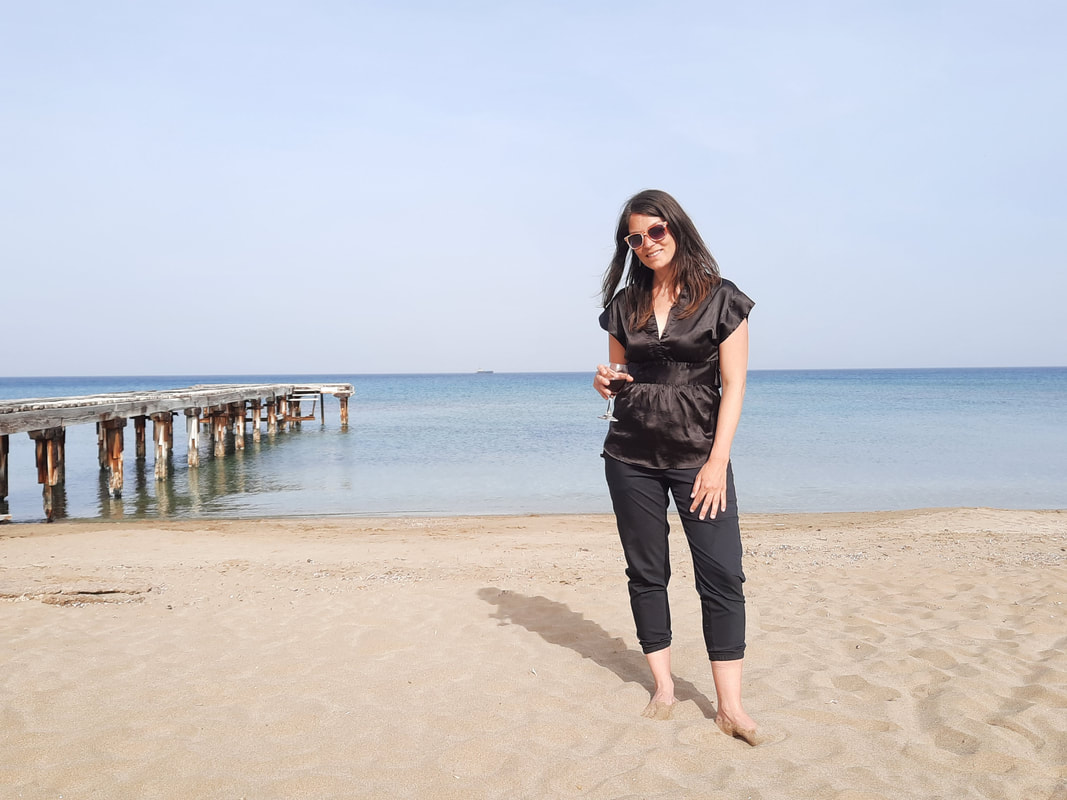
Budget Bites
- Budget Supermarkets: Lidl; Plus Discount; Athienitis; Sklavenitis; Metro; AlphaMega.
- Markets: Every city has its own market, usually housed in a separate building. Take note that in Southern Cyprus markets are actually more expensive than supermarkets. In Northern Cyprus markets are definitely cheaper than the supermarkets.
- Local Dishes: Mezze (tapas); Şeftali Kebab (sausages); Kleftiko (roasted lamb meat); Souvlaki (BBQ meat); Moussaka (Greek lasagne); Koupepia / Dolma (rice/meat in wine leaves); Louvi (bean dish); Pilafi Pourgouri (bulgur); Makaoronia Tou Fournou (macaroni lasagne); Stifado (stew); Kotopoulo me Kolokassi (chicken with taro potatoes); Ttavas (claypot dish); Molehiya (dried leaves); Pirohu (cheese / mint pastry); Böreği (pastry); Zeytinli (olive bread); Çörek (sweet bread), Tahinli (tahini bread); Ekmek Kadayıfı (bread pudding); Tarhana (dried wheat / yoghurt); Baf Chewing Gum (natural chewing gum); Ceviz Macunu (walnuts in syrup); Loukomades (deepfried dough balls with honey); Halloumi Cheese.
- The Veg Situation: Going veg is rather complicated in Cyprus, as they love their meat and fish in both the Greek and Turkish side. However, where there’s a will there’s a way. Find all veg-friendly restaurants in this destination here. Local veg dishes: Certain Mezze; Koupepia / Dolma with just rice (vegan); Louvi (vegan); Molehiya (vegan); Pirohu / Böreği with cheese or spinach; Zeytinli; Çörek; Tahinli; Ekmek Kadayıfı; Tarhana; Baf Chewing Gum; Ceviz Macunu; Loukomades; Halloumi Cheese.
- National Drink: Cypriot Wine (commandaria is the most famous); Keo Beer; Zivaniya (pomace brandy); Ouzo (anice-tasting alcoholic beverage); Filfar (liquor); Brandy Sour (cocktail); Ayran (yoghurt drink). Traditional coffee is prepared Turkish style: very strong with the grains still in the cup.
Sleep Cheap
Mama Said
- Hostels / Hotels: Accommodation is incredibly expensive in Southern Cyprus (comparable to Greece), but relatively affordable in the North (although definitely not as cheap as in Turkey). If you’re with 2 people or more, a private room or apartment is already cheaper than a dormitory bed in a hostel. I personally found the best deals on Booking.com, which is much cheaper than Air BnB listings here. Booking.com also has the biggest selection, is transparent about the final price and had an efficient search engine tailored to your specific needs. If you use it often enough, generous Genius-discounts are applied. Agoda is often not transparent about prices, adding a lot of additional costs in the last booking-step. Opodo is a better alternative. Writer's choice: I stayed in Lefkosa, Gazimagusa and Girne by the means of Couchsurfing.
- Couchsurfing: allows you to stay with locals. Nowadays it has a moderate sign-up cost (unless you put a third-world country as homebase), but paying extra for verification is unnecessary: Positive reviews are way more important. Once active, there are no costs for staying at someone’s house. In order to get accepted, make sure to write an elaborate review explaining why you applied to this specific profile and think you and your host are a good match (copy-pastes tend to be ignored). In order to avoid the high accommodation costs of Cyprus and meet locals, I made great use of the Couchsurfing communities in both the north and south of Cyprus.
- Housesitting: is an amazing exchange allowing you to stay short- or long-term in somebody’s house, while looking after their house and pets. There are many different websites, most of them paid… but once you landed a sit, the subscription fee is pays itself back quickly. The main housesitting site is Trusted Housesitters.
- Wild Camping: is illegal in Cyprus. However, in the northern side it’s not strongly enforced. If you avoid beaches and protected areas, you are unlikely to run into problems.
Mama Said
- Safety: European countries like Cyprus are generally safe, both the north and south, but use your common sense like everywhere. Don’t walk alone in remote areas after sunset, don’t take valuables along and follow your instincts when entering certain neighbourhoods further away from the centre.
- Tap Water: is drinkable.
- Ethics: Boycott zoos like where animals are held in captivity.
- The best credit/debit card for traveling is Wise, as they use the live conversion rates without any extra fees. Wise also has the lowest fees for sending money to foreign accounts. Keep in mind that many ATMs charge a fee, the amount always indicated before completing the transaction. Payment by card is generally accepted everywhere.
- Simcard: Keep in mind that a simcard bought in the south doesn’t work in the north, and the other way around. In the South, Epic, Vodafone and Primetel are most used and data prices are amongst the highest in Europe. In the North, Turkcell and Tellsim are the main prepaid networks, and rates are much lower. Whereas Turkey applies restrictions and taxes to foreign mobile phones, this isn’t the case in North Cyprus. EU laws for roaming don’t apply in North Cyprus. In the North you have to register your simcard, whereas in the South you can just buy a sim at any kiosk without registration.
Transport
Next?
- Walking: Within the cities, most distances can be reached on foot. To reach the suburbs of bigger cities such as Nicosia or Limassol, alternative transport is recommended.
- Cycling: Cycling is an easy option, although traffic can be inconsiderate for cyclists. The bike-share system in the South is called Nextbike (only available in Nicosia and Limassol), in the North it’s Velespeed (available in Nicosia and Famagusta).
- City Buses / Tram / Metro: Cyprus is connected by a bus system. In the South it’s rather organized, with buses leaving on set times advertised online. However, I have experiences of buses not showing up at all. The prices are quite high, but local student discounts apply for intercity buses. Greek Cypriot bus drivers are notoriously grumpy. In the North the bus system is far less organized and rather hectic, operating on a they-come-when-they-come-basis and stopping everywhere along the road. That said, it’s much cheaper. Public transport only connects the main cities… for more remote nature destinations you either need to hitchhike or rent a car.
- Taxi / Uber: The local Uber in Cyprus is Bolt, which operates in the main cities (incl. the northern Famagusta). You can also hail down a taxi on the street, but always negotiate the price before getting in. As expected, it’s more expensive in the South.
- Train: Not available in Cyprus.
- Car Rental: Keep in mind that you often need to pay a fee and/or insurance to move the car from the North to the South. Prices are overall rather high, compared to the rest of Europe.
- Airport: Paphos International Airport (PFO); Larnaca International Airport (LCA); Ercan Arport (ECN) in the North. Cheap city buses run to the neighboring towns, so you can avoid taking a taxi. Keep in mind that if you enter via the South you have to leave via the South, and if you enter in the North you have to leave via the North, otherwise you miss a passport stamp. You can move in between the North and South during your stay without problems, as long as you leave on the side you came from. The North is only recognized by Turkey and their port and airport are internationally recognized as illegal entry/exit points into Cyprus.
- Hitchhiking: is relatively safe in North Cyprus, but noy very common in te South.
Next?
In order to support the travelers’ community, I spend many hours per week to adequately document all information and advices for prospective visitors, accompanied by a (hopefully) entertaining insight into my personal observations and experiences. This service is and will remain free. However, if you voluntarily want to make a contribution and support my travels and thus the creation of new stories and information supply, here is the button you’re looking for:
Related:
- Explore Cyprus: Check out the Cyprus Nature and Cyprus Top-5 Cities Blogs!
- Get deep into Greece: Athens, Delphi, Arachova, Mount Parnassos NP, Epirus, Meteora, Thessaloniki & Volos
- Archeological treasures, UNESCO sights and Greece's roughest nature: Explore the Peloponnese!
- Be about Bulgaria: Check off Bansko, Belogradchik, Plovdiv, Sofia and of course Veliko Tarnovo!
- Check out Budget Bucket List's FAVORITE HIKING DESTINATIONS worldwide!
- Visit Balkan's finest: Montenegro's National Parks Blog, Kotor Bay & Lovcen NP and Cetinje, Podgorica, Prokletije NP and Montenegro's Coastal Towns Blog
- 10 typical Dutch celebrations no traveller should miss out on
- History preserved: Time capsule of Romanian culture Maramures
- Get your Albania itinerary ready: Berat, Gjirokastër, Korcë / Ohrid Lake, Theth, Shkodër, Tirana, Mount Korab & the coast!
- Where modern meets classic: Vilnius, Lithuania
- 8 ways to save money in Vienna, Austria
- German gems: Aachen & Frankfurt am Main
- Europe's best skiing & hiking: Get your ass over to jaw-dropping Switzerland!
- Budget Bucket List hitchhike trip to... Kosovo!
- Unravel the mysteries of Serbia
- Discover the splendours of Turkey: Istanbul on a Budget & Reasons to visit Edirne
- Explore Cyprus: Check out the Cyprus Nature and Cyprus Top-5 Cities Blogs!
- Get deep into Greece: Athens, Delphi, Arachova, Mount Parnassos NP, Epirus, Meteora, Thessaloniki & Volos
- Archeological treasures, UNESCO sights and Greece's roughest nature: Explore the Peloponnese!
- Be about Bulgaria: Check off Bansko, Belogradchik, Plovdiv, Sofia and of course Veliko Tarnovo!
- Check out Budget Bucket List's FAVORITE HIKING DESTINATIONS worldwide!
- Visit Balkan's finest: Montenegro's National Parks Blog, Kotor Bay & Lovcen NP and Cetinje, Podgorica, Prokletije NP and Montenegro's Coastal Towns Blog
- 10 typical Dutch celebrations no traveller should miss out on
- History preserved: Time capsule of Romanian culture Maramures
- Get your Albania itinerary ready: Berat, Gjirokastër, Korcë / Ohrid Lake, Theth, Shkodër, Tirana, Mount Korab & the coast!
- Where modern meets classic: Vilnius, Lithuania
- 8 ways to save money in Vienna, Austria
- German gems: Aachen & Frankfurt am Main
- Europe's best skiing & hiking: Get your ass over to jaw-dropping Switzerland!
- Budget Bucket List hitchhike trip to... Kosovo!
- Unravel the mysteries of Serbia
- Discover the splendours of Turkey: Istanbul on a Budget & Reasons to visit Edirne
